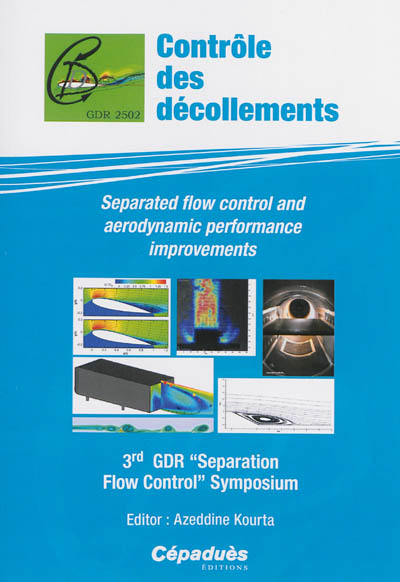en savoir plus

Permet à tous ses détenteurs d'obtenir 5% de réduction sur tous les livres lors du retrait en magasin (réduction non cumulable avec les réductions de type étudiant).
Offre également un certain nombre d'avantages auprès de nos partenaires.
Avec les favoris, retrouvez dans un espace les sélections effectuées au fur et à mesure de vos navigations dans le site.
Constituez pour votre usage personnel vos listes de livres en prévisions d'achats futurs et votre sélection d'articles, dossiers, événements, vidéos ou podcasts préférés ou à découvrir plus tard...
Il suffit simplement de cliquer sur "Ajout Favori" sur chaque page qui vous intéresse pour les retrouver ensuite dans votre espace personnel.
Requiert un compte Mollat
Requiert un compte Mollat
Separated flow control and aerodynamic performance improvements
Auteur : Contrôle des décollements (Toulouse). Symposium (3 ; Orléans)
en savoir plus
Résumé
Contributions consacrées aux problèmes du décollement, aux structures tourbillonnaires et aux conséquences qui en découlent. ©Electre 2025
Quatrième de couverture
« Separation flow Control »
The conception of aeronautic System or road vehicle faces challenging issues such as : prediction of receptivity modes generated by the actuation, development of optimal and robust control, closed loop, conception of micro-scale actuators and sensors, optimal use of energy conversion, establishment of measure fast estimation process. ... To address these issues, a better understanding of underlying physics and related interactions are needed.
In the context of aerodynamic performance which is comerstone in both aeronautic and automotive domains, the flow separation presents an important issue challenge. This mechanism leads to a decrease of performances. One way to improve these situations is to use a control. This control must be active and low cost.
The efficiency of the control is closely dependent on the used Systems and technics. To reach this goal, scientific and technical progresses are needed. On the scientific point of view. mechanisms leading to a separation have to be analyzed and characterized. Also. the actuation has to be efficient and low cost. The technical goal concerns both the sensor and actuator Systems. More exactly which parameter has to be selected to first apply the actuation and then to evaluate the results by using suitable sensors. For the actuation, it relies on the choice of high quality actuator to develop and to be able to satisfy fulfill requirements.
GDR (Groupement De Recherche / Joint Research Project) is a CNRS federative project between French university research laboratories and ONERA departments working in the framework of flow control and sensors or actuators technologies. Aeronautical and car industries interested in using flow control are also involved as partnership (Dassault-Aviation. PSA, Renault, SNECMA, Plastic-Omnium, Eurocopter). The GDR is a multi-disciplinary network. The objective of this national network is to devolop a collaborative project from the fundamental concept to a full scale demonstrator.
The control of high lift induced separation on airfoil may improve the flight envelope of current aircraft or even simplify the complex and heavy high-lift devices on commercial airframes. This is also the case for car vehicle where the control can improve drag, reduce noise and hence reduce pollutant emissions and fuel consumption. The work involved here coverss experimental, numerical and theoretical studies done in the context of French national program (GDR2502 « Flow Separation Control ») devoted to design better actuators and to set up optimal and robust control.
In the context of the GDR program, development of sensors and actuators is also concerned. Many techniques have been used to produce continuous jets, pulsed jets or synthetic jets. Mechanical, acoustical, magneto - dynamical, piezo - electrical, plasmas ... techniques have been used. The developed prototypes reach the level required for a practical application of control. The acoustic or piezo-electrical synthetic jets have been used to enhance the lift of the airfoil or to decrease the drag on the car configuration. The MEMS actuators have been also used. The plasma is also used on the airfoil to prevent separation.
Both open and closed loops have been satisfactory tested. The reduced order model is used to better analyze the effect of control and to perform optimization.
Fiche Technique
Paru le : 28/10/2013
Thématique : Mécanique
Auteur(s) : Auteur : Contrôle des décollements (Toulouse). Symposium (3 ; Orléans)
Éditeur(s) :
Cépaduès
Collection(s) : Non précisé.
Contributeur(s) : Editeur scientifique (ou intellectuel) : Azeddine Kourta
Série(s) : Non précisé.
ISBN : 978-2-36493-085-8
EAN13 : 9782364930858
Reliure : Broché
Pages : 197
Hauteur: 24.0 cm / Largeur 17.0 cm
Épaisseur: 1.1 cm
Poids: 363 g

